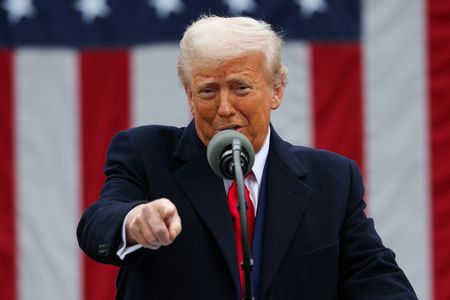By Jamie McGeever
ORLANDO, Florida (Reuters) – TRADING DAY
Only 24 hours until Trump unveils new tariffs
The first trading day of the quarter on Tuesday was a nervy affair ahead of U.S. President Donald Trump’s “Liberation Day” on Wednesday, with markets struggling for clear direction as Trump’s new trade barriers loomed into view.
Stocks mostly rose but U.S. Treasury yields tumbled, while gold and the dollar broadly held steady. Talking of the greenback, I will dig deeper into the IMF’s latest FX reserves data below, but first, here are the scores on the doors from Tuesday’s trading around the world.
Today’s Key Market Moves.
* A late surge on Wall Street lifts the Nasdaq and S&P 500out of the red. The Nasdaq rises 0.8%, the S&P 500 gains for asecond day. * Tesla shares rebound 3.6% ahead of its first-quartervehicle deliveries report on Wednesday. * U.S. Treasury yields fall across the curve. A 9 bpsdecline at the long end bull flattens the curve. * Benchmark European stocks rise more than 1% for their bestday in two weeks. * The dollar index holds steady, with gains against the eurooffset by losses against the yen and Australian dollar. * Bitcoin rises 3% back above $85,000, its best day innearly three weeks.
The specter of Trump’s new tariffs on Wednesday has sucked the oxygen out of world markets in recent weeks, and despite the generally positive performance on Tuesday, anyone hoping life will be injected back into them once the announcement is made is setting themselves up for disappointment.
There’s simply too much uncertainty and too little visibility around how the new tariffs will work, how long they will be in place, what exemptions or concessions there may be, how other countries will react, and what the implications will be for specific sectors, markets and asset classes.
To paraphrase former U.S. Defense Secretary Donald Rumsfeld, that’s a lot of known unknowns, and a fair sprinkling of unknown unknowns too. That fog of uncertainty won’t lift on Wednesday, and indeed, is more likely to thicken – hardly the conducive environment for investors, consumers and businesses to get spending.
An announcement has been scheduled for 4 p.m. Eastern Time (2000 GMT) on Wednesday, and it wouldn’t be surprising if investors try to maintain a holding pattern across markets until then as best they can.
The longer term dilemma they and policymakers face was encapsulated in a couple of U.S. economic indicators on Tuesday that showed manufacturing slipping back into contraction, and a measure of factory gate inflation jumping to the highest in nearly three years.
Stagflation risks are rising, markets are skittish, and the common denominator is Trump’s tariff agenda.
Japanese stock futures point to the benchmark Nikkei 225 index rising around 0.4% at the open on Wednesday, a pretty small bounce considering the index had plunged 4% on Monday.
Dollar’s record low FX reserves share not all bad news for Trump
In January, U.S. President Donald Trump warned the so-called BRICS nations against replacing, or backing any currency to take the place of, the “mighty U.S. dollar.”
While the International Monetary Fund’s latest foreign exchange reserves data for the fourth quarter of last year suggests central banks around the world continue to pull away from the greenback, there may be a silver lining for the president.
The IMF’s Currency Composition of Official Foreign Exchange Reserves (Cofer) data, the gold standard for FX reserves information, show that countries have been gradually chipping away at their dollar holdings and diversifying for years.
Indeed, the greenback’s nominal share of official FX reserve holdings in the third quarter of last year fell to a record low 57.3% from over 72.0% in 2001.
That crept up slightly to 57.8% in the fourth quarter, a rare rise, but the dollar surged 7.6% against a basket of major currencies in the period, its biggest quarterly appreciation in nearly a decade. All else equal, this reduces the dollar value of reserves held in non-dollar currencies such as the euro, sterling, or Japanese yen.
When adjusting for these FX changes, the dollar’s share of reserves slid to a record low of 54.1% from 55.3%, according to Goldman Sachs. At the start of the millennium, that share was over 71%.
Importantly, the Cofer figures only go up to December 31, so do not take into account any reserve shifts made amid the historically high policy uncertainty and market ructions of recent months.
With military, diplomatic and trade ties going back decades now fraying at an alarming rate, reserve managers are bound to be rethinking their FX allocations. And that is unlikely to involve a sudden re-discovered love for the dollar.
STILL NUMBER ONE
Reserve managers do not typically make knee-jerk reactions to market gyrations or the headlines du jour. They’re a cautious breed, prioritizing liquidity, stability and long-termism over yield, opportunity and a fast buck.
But further diversification of their FX reserves can hardly be considered an impulsive reaction, as the trend is pretty well entrenched. The emergence of any new world order in the coming years would likely only strengthen it.
No matter how you slice it, the dollar’s overwhelming dominance in global FX reserves is weakening. But that doesn’t mean the greenback’s place as the world’s preeminent reserve currency is under threat.
Its share is not being eaten up by its nearest rival, the euro, but by a bunch of smaller, “nontraditional” reserve currencies such as the Korean won, Australian and Canadian dollars, and China’s renminbi.
“It’s not just diversification out of the dollar. Euro reserve holdings have fallen in nominal and valuation-adjusted terms as well,” notes Goldman’s Michael Cahill.
This is a trend that has been underway for years, taking hold just after the Global Financial Crisis and accelerating again after the pandemic.
The Cofer data shows the aggregate share of “nontraditional” currencies in central banks’ FX reserves was 12.6% in December, just off September’s record high of 12.7%. Before 2009, that share had never exceeded 3%.
The euro’s share since its launch more than 25 years ago has never fallen below 19% and only once, in late 2020, has it exceeded 21%. Any reduction in the difference between the dollar and euro shares has been caused by reserve managers shunning the greenback rather than taking a shine to the euro.
Their preference to build up holdings of several smaller currencies has created a somewhat curious equilibrium. The dollar is seeing its dominance gradually diminish, but it’s in little danger of losing its role as the world’s sole reserve currency.
Trump, who seems to want the dollar to remain dominant while no longer sucking in so much of the world’s savings, may be happy with that.
What could move markets tomorrow?
* South Korea inflation (March) * India manufacturing PMI (March) * ECB board member Isabel Schnabel delivers keynote speech * ECB President Christine Lagarde speaks * Fed Governor Adriana Kugler speaks on inflationexpectations * U.S. ADP private sector employment (March)
If you have more time to read today, here are a few articles I recommend to help you make sense of what happened in markets today.
1. Tesla sales rout in Europe deepens amid anti-Muskprotests 2. US bond manager PIMCO looks abroad as US exceptionalismfades 3. Investors pour record $11 billion into Europe ETFs to’Make Europe Great Again’ 4. Trump tariffs hinder M&A and IPOs in what was supposedto be a blockbuster quarter 5. Trump tariff liberation means endless complication
I’d love to hear from you, so please reach out to me with comments at . You can also follow me at [@ReutersJamie and @reutersjamie.bsky.social.]
Opinions expressed are those of the author. They do not reflect the views of Reuters News, which, under the Trust Principles, is committed to integrity, independence, and freedom from bias.
Trading Day is also sent by email every weekday morning. Think your friend or colleague should know about us? Forward this newsletter to them. They can also sign up here.
(By Jamie McGeever)











